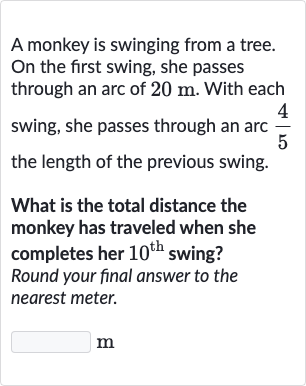AI tutor
Welcome to Bytelearn!
Let’s check out your problem:

A monkey is swinging from a tree. On the first swing, she passes through an arc of . With each swing, she passes through an arc the length of the previous swing.What is the total distance the monkey has traveled when she completes her swing? Round your final answer to the nearest meter.m
Full solution
Q. A monkey is swinging from a tree. On the first swing, she passes through an arc of . With each swing, she passes through an arc the length of the previous swing.What is the total distance the monkey has traveled when she completes her swing? Round your final answer to the nearest meter.m
- Identify initial arc length: Identify the initial length of the arc for the first swing and the pattern of the decrease in the length of the arc for each subsequent swing.The initial length of the arc for the first swing is meters. The length of each subsequent swing is times the length of the previous swing.
- Calculate total distance: Calculate the total distance traveled by the monkey over the swings using the formula for the sum of a geometric series.The sum of a geometric series is given by , where is the first term, is the common ratio, and is the number of terms.Here, , , and .
- Plug values into formula: Plug the values into the formula to calculate the sum of the first terms of the geometric series.
- Simplify expression to find sum: Simplify the expression to find the sum . Calculate using a calculator.Now, substitute this value into the expression.
- Round final answer: Round the final answer to the nearest meter. meters
